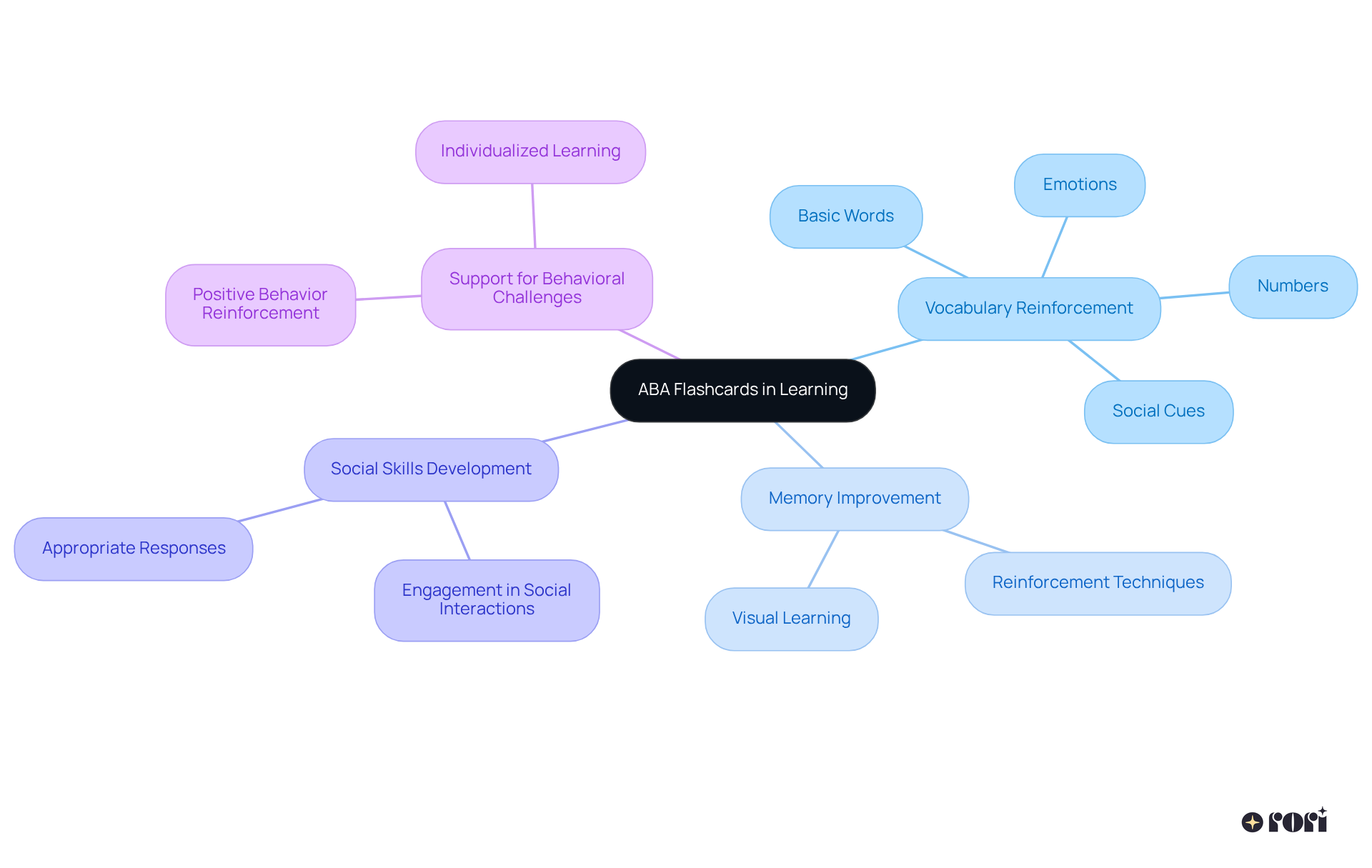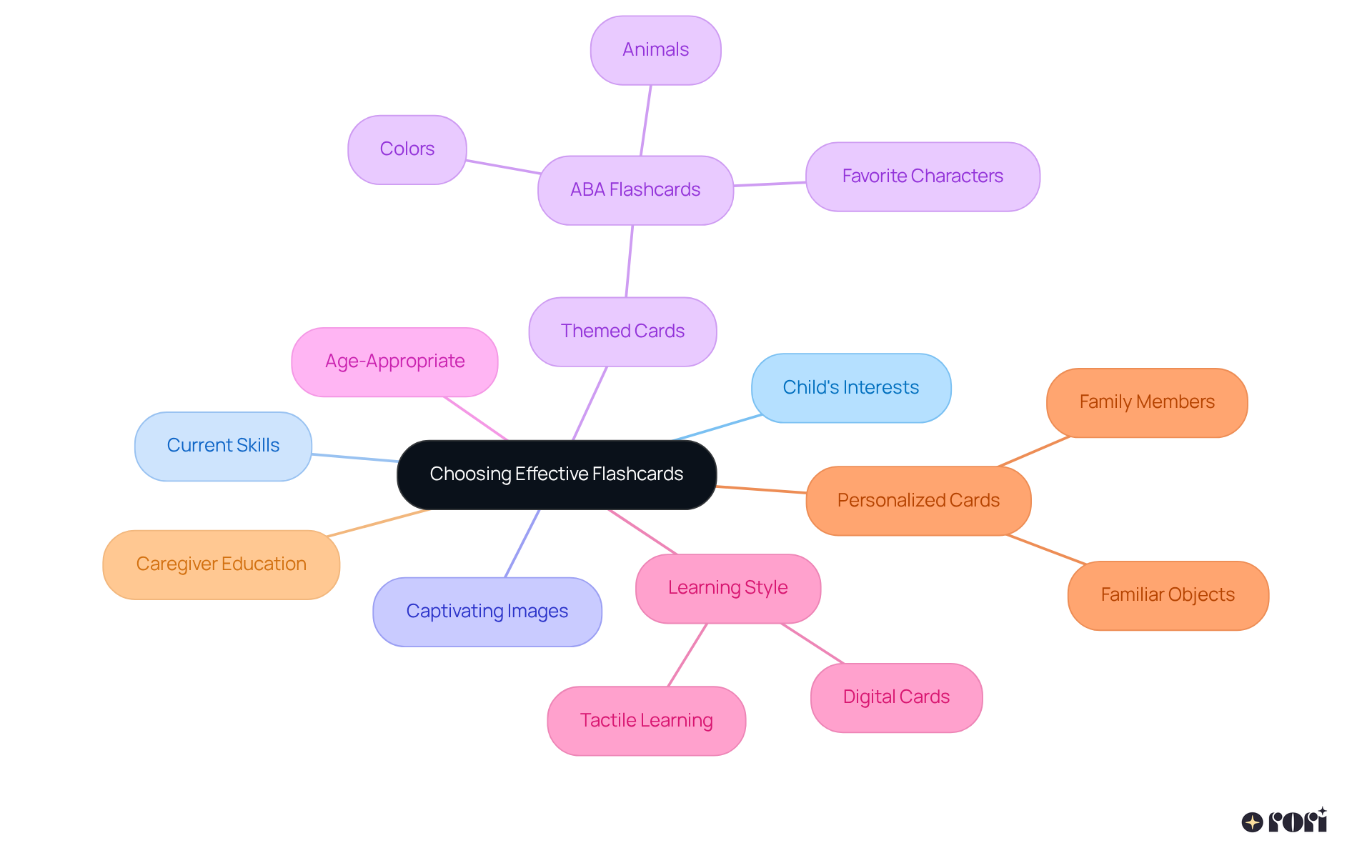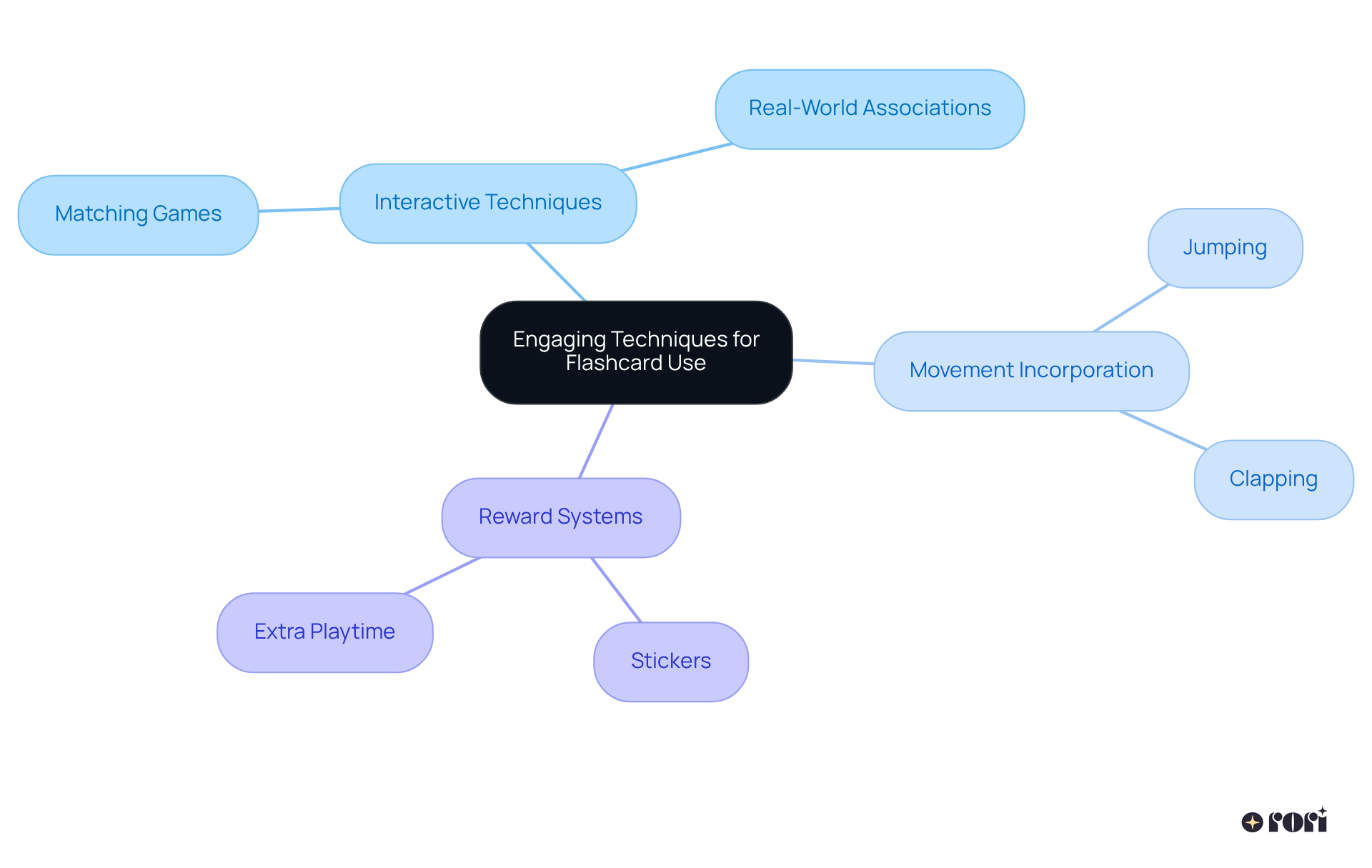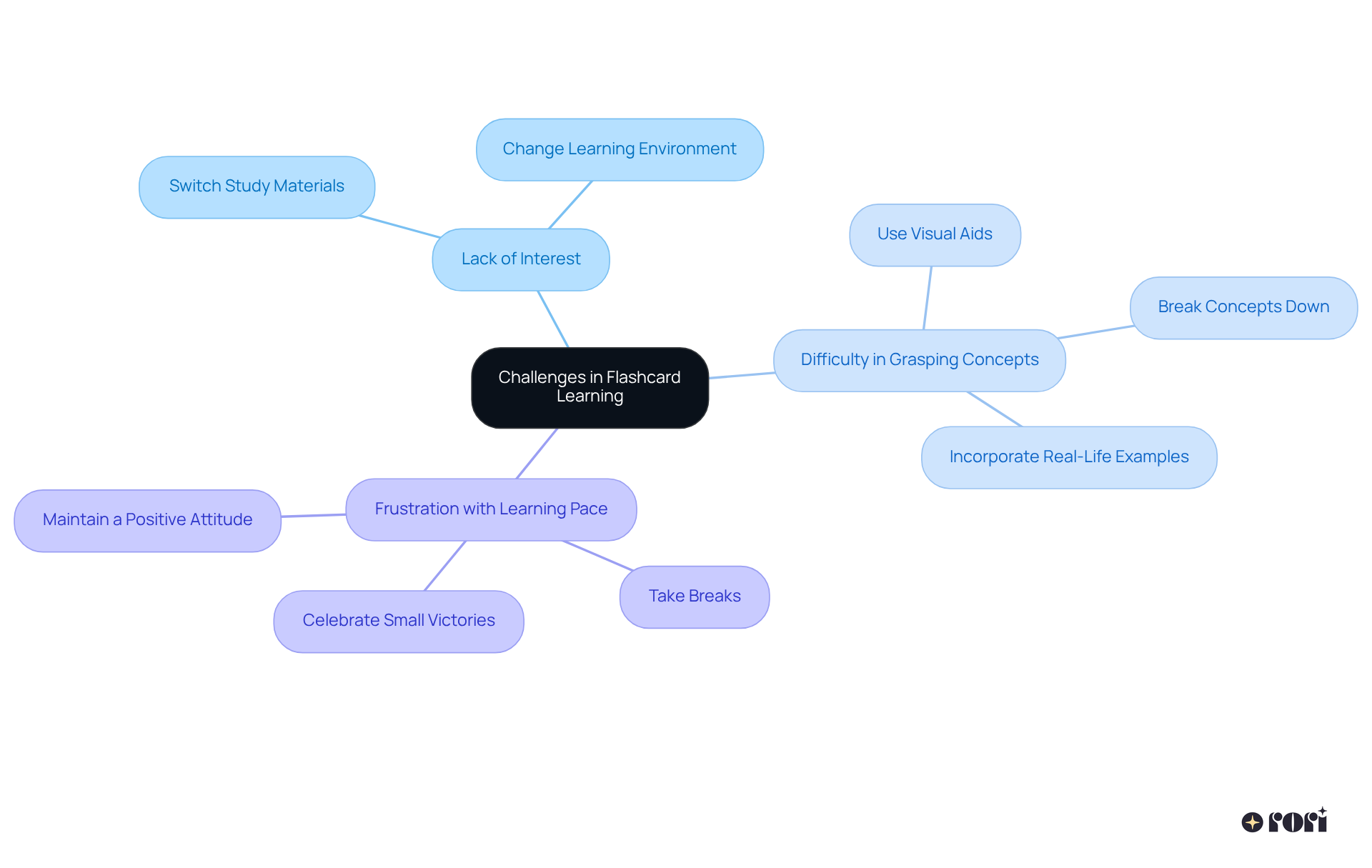This article shares four simple steps to help you effectively use ABA flashcards with your child. It highlights how essential it is to make learning fun and tailored to your child's unique interests and needs. To support you, it offers strategies for picking the right flashcards, using interactive techniques, and tackling common learning challenges. All of this is aimed at boosting communication skills and overall development for children with autism.
Let’s explore this together! By selecting engaging flashcards, you can create a learning experience that resonates with your child. Think about their favorite themes or characters—this connection can make all the difference! Plus, implementing interactive techniques, like games or songs, can turn learning into a delightful adventure.
We understand that every child is different, and that’s okay! If you encounter any challenges along the way, remember that you’re not alone. Many parents face similar hurdles, and there are resources available to help you navigate through them. So, don’t hesitate to reach out for support!
In the end, the goal is to enhance your child's communication skills while fostering their overall growth. Keep it light, keep it fun, and most importantly, keep it connected to what your child loves. We’re here to help you every step of the way!
ABA flashcards have become a fantastic educational tool, especially for children on the autism spectrum who encounter unique behavioral challenges. These visual aids not only boost vocabulary and memory but also play a vital role in developing social skills.
But here’s the real question: how can we effectively engage our little ones with these flashcards to unlock their full learning potential? 🤔
What techniques can caregivers use to turn flashcard sessions into exciting and productive experiences that encourage growth and independence?
Let’s explore this together!
Kids with autism can feel ABA flashcards excited as they serve as a wonderful resource, especially for those struggling with behavioral challenges or skill gaps. They do so much, like reinforcing vocabulary, improving memory, and boosting social skills. You can use flashcards to teach everything from basic words and numbers to more complex ideas like emotions and social cues. By showing information visually, tools such as ABA flashcards excited cater to the learning styles of many children on the autism spectrum, making learning more accessible and enjoyable. Understanding this is the first step to using study aids effectively to support your child's development.
Incorporating ABA flashcards excited into therapy sessions can really help reinforce positive behaviors and responses, aligning perfectly with the principles of Applied Behavior Analysis. This approach is all about your child’s individual needs, and when used consistently, visual aids can help them make connections between words and their meanings. Ultimately, this leads to better communication skills and increased independence. With this understanding, you'll be able to use study aids more effectively in your child's educational journey, enhancing their social skills and overall growth. Let’s explore this together!

Choosing the right study cards is so important for helping individuals with autism learn effectively. Start by thinking about your child's interests and current skills to make sure the materials resonate with them. Look for cards that feature captivating images and simple text. Themed flashcards, like ABA flashcards excited that showcase animals, colors, or favorite characters, can really boost motivation and engagement.
It's also crucial to pick age-appropriate cards that align with your child's unique learning style. For example, some kids might benefit from tactile learning cards that they can touch and manipulate, while others may thrive with digital cards that include sounds or animations. Plus, consider making personalized flashcards that include pictures of family members, pets, or familiar objects. This makes the learning experience more relatable and enjoyable! This customized approach not only increases involvement but also helps develop essential skills in a fun and meaningful way, making ABA flashcards excited for learners.
By equipping caregivers with ABA principles and strategies, they can make informed choices that positively impact their child’s progress. This education enhances support and leads to better behavioral outcomes, aligning with Rori Care - ABA Therapy’s mission to improve behavior, develop social skills, and foster independence in individuals with autism. Let’s explore this together!

Making learning with aba flashcards excited can turn into a fun adventure! By using a variety of interactive techniques, you can foster engagement while empowering caregivers to support their children's behavioral goals. Start with short, focused sessions to keep things fresh and prevent fatigue.
How about incorporating activities like matching games? Kids can connect flashcards to corresponding objects or images found around the house, which helps them understand concepts through real-world associations. Research shows that young learners benefit from seeing themselves in educational resources, boosting their self-worth and involvement. For instance, the Brown Brilliance Collection provides representation in educational materials, making it easier for kids to relate to what they’re studying.
Let’s add some movement! Encourage your little one to jump or clap when they correctly identify a flashcard. This kinesthetic approach not only makes learning enjoyable but also creates an environment where aba flashcards excited significantly boosts memory retention. Studies indicate that movement-based instruction can enhance recall in youth.
Plus, consider introducing a reward system, like stickers or extra playtime, to cheer on your child and celebrate their achievements. As one ABA therapist wisely noted, "Utilizing visual aids is an effective method for involving youngsters in education, particularly when paired with physical activity and incentives."
By mixing up your methods and keeping the atmosphere lively, you can create a positive educational environment that encourages active participation and enthusiasm in your child's academic journey. This ultimately leads to improved behavioral outcomes. Let’s explore this together!

Even with the best intentions, challenges can pop up during card study. Common issues include:
If your child seems indifferent, think about switching up the study materials or the learning environment. Sometimes, a fresh setting or different flashcards can make the aba flashcards exciting and spark their enthusiasm! 🌟
If your child is having a tough time with certain concepts, try breaking them down into smaller, more manageable parts. You can use extra visual aids or real-life examples to help reinforce their understanding. This approach not only aids comprehension but also aligns with ABA principles, allowing you as a caregiver to make informed choices that enhance your child's learning experience.
When frustration arises, don’t hesitate to take a break and later revisit the aba flashcards excited. Remember, patience is key! Celebrate those small victories and keep a positive attitude to encourage your child to keep trying. By being proactive and adaptable, you can effectively troubleshoot challenges and create a supportive educational atmosphere. Your active involvement and alignment with therapeutic strategies can lead to better behavioral outcomes, fostering a more effective and lasting learning experience for your child. Let’s explore this together!

Using ABA flashcards can truly transform the learning experience for children on the autism spectrum, making it not just effective but also enjoyable! By understanding their role and implementing engaging techniques, caregivers can significantly boost their child's communication skills, independence, and overall development. Remember, the journey of learning with flashcards isn’t just about the information; it’s about fostering a connection that resonates with each child's unique needs.
Key strategies like choosing relevant flashcards, incorporating interactive techniques, and troubleshooting common challenges are essential for maximizing the benefits of ABA flashcards. Tailoring the learning experience to align with a child's interests and learning styles can spark increased motivation and engagement. Plus, using creative methods like movement and rewards can create a vibrant learning atmosphere that encourages participation and enthusiasm!
In conclusion, embracing the use of ABA flashcards opens up a world of possibilities for children with autism. By actively engaging in their educational journey and adapting strategies to overcome challenges, caregivers can facilitate meaningful learning experiences that promote growth and independence. This approach not only enhances academic skills but also nurtures social connections and emotional understanding, ultimately laying a solid foundation for lifelong learning. Let’s explore this together and make a difference in our children's lives!
What are ABA flashcards and their purpose in learning?
ABA flashcards are visual tools used to support children with autism in learning. They help reinforce vocabulary, improve memory, and boost social skills by providing a visual representation of information.
How do ABA flashcards benefit children on the autism spectrum?
They cater to various learning styles, making learning more accessible and enjoyable. Flashcards can teach basic words and numbers, as well as more complex concepts like emotions and social cues.
How can ABA flashcards be incorporated into therapy sessions?
They can be used to reinforce positive behaviors and responses, aligning with the principles of Applied Behavior Analysis, which focuses on the individual needs of the child.
What skills can ABA flashcards help develop in children?
They can help develop communication skills and increase independence by enabling children to make connections between words and their meanings.
What is the overall goal of using ABA flashcards in a child's educational journey?
The goal is to enhance the child's social skills and overall growth by using study aids effectively to support their development.